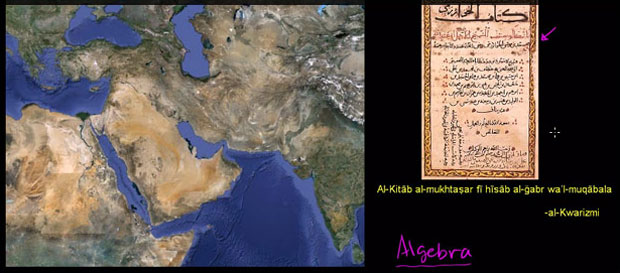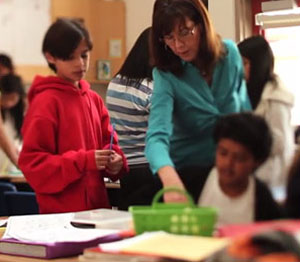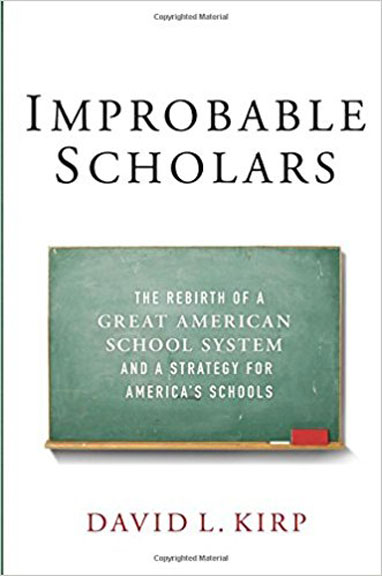Featured Book
One World Schoolhouse
Education Reimagined
Who knows where genius will crop up? There may be a young girl in an African village with the potential to find a cancer cure. A fisherman’s son in New Guinea might have incredible insight into the health of the oceans. Why would we allow their talents to be wasted? How can we justify not offering those children a world-class education, given that the technology and resources to do so are available – if only we can muster the vision and the boldness to make it happen?
Salman Khan presents his vision for a new approach to education, which he argues could fundamentally transform the learning experience for students everywhere, at every level, into a self-directed, lifelong, creative process.
What do we need from education?
Today’s world needs a workforce of creative, curious and self-directed lifelong learners who are capable of conceiving and implementing novel ideas. The pace of change is now so swift that deep creativity and analytical thinking are no longer optional, they have become survival skills. The traditional education system is no longer adequate. What matters now is whether the world will have an empowered, productive, fulfilled population in the generations to come, one that fully taps into its potential and can meaningfully uphold the responsibilities of life in complex societies.
The crucial task of education is to teach students how to learn. Beyond the fundamentals of literacy and arithmetic, students must acquire the skills and interests to continue their own learning processes.
How can a new approach meet those needs?
By combining the enlightened use of technology with the best teaching practices, we can deliver the most relevant and comprehensive curriculum at the lowest cost, equally available to everyone. We can foster students who are capable of self-directed learning, deep understanding of fundamentals, and creative approaches to real-world problems. And in the process, we can nurture the curiosity and mental tools needed for lifelong learning.
We can harness technology to serve this new vision – to distribute material quickly and cheaply, present concepts interactively, organize large collections of information, generate feedback to students and teachers, and monitor performance. This would free teachers from the time consuming duties of lecturing and grading assignments, giving them maximum opportunity for one-on-one coaching and supporting students in individual and group learning activities.
Where does the traditional classroom model fall short?

For over two hundred years, Western countries have relied on an educational model whose goals are two-fold: firstly, to build a foundation of basic skills needed to support industry; and secondly, to provide “higher” education and leadership opportunities for a relatively few elite students. Creativity and discovery have been de-emphasized in favor of standardization, and students have been channeled from early age, either de facto or intentionally, into higher or lower tracks based on assumptions about what they will be best suited for later in life.
Many schools believe their tracking structures are based on students’ potential. However, the assessment methods they use measure achievement at particular points in time, rather than potential for learning. It may not even be possible to accurately assess potential separately from achievement. Furthermore, a tracking program is never a neutral process, but in itself exerts powerful influences on the assumptions and performance of students, teachers, parents and curriculum planners. Clearly, the stratified education model does not serve the needs of the modern world, where all citizens need a robust awareness of the world around them, and many will eventually be needed in careers that didn’t exist when they started school. We can no longer afford to segregate the population into workers, thinkers, creators and leaders, or to halt the learning process when we leave school.
In the traditional system, new concepts are introduced to a class via lecture-style presentation, according to a curriculum calendar, regardless of individual rates of learning. Students are then expected to assimilate and memorize the material outside of class time, through homework assignments and study. Exams are given to all students at the same points in the course. This lecture/ homework/ calendar model mandates that all students move through the material at the same pace, causing some to become bored and forcing others ahead before they have mastered more basic material, setting them up for more difficulties later. Students with financial and family resources (including parents who are more highly educated) fare better than those without, thus continuing the pattern of stratification.
Another hallmark of the traditional system is fragmentation – of the school day into discrete learning periods of arbitrary length; and fragmentation of knowledge into arbitrarily divided subjects. Time fragmentation is a problem because it interferes with natural learning rhythms and capacities, and because it mandates a single structure for all students, preventing individuals from managing their own learning process to their best advantage.

Subject fragmentation is even more damaging. Arbitrary divisions between subjects obscure the very connections that are essential to deep understanding. For example, it is possible for a student to pass both biology and chemistry in high school without gaining an understanding of how they are fundamentally related. Similarly, there are topics in history, the arts, sciences and philosophy that can only be understood deeply in connection with each other. Not only is deeper understanding possible, but memory is greatly aided when we learn information as associated collections rather than isolated pieces.
Another shortcoming of the traditional approach is the practice of dissociating course material from meaningful applications, for example, math problems that talk about the speed of trains or chances of rolling two sixes. To spark creative approaches to problem solving, math could tap into a world of issues more urgent and intrinsically interesting. Most students who graduate from high school, and many from college, have little notion of the relevance of what they studied to what goes on in the world they live in.
Age segregation poses other problems in the traditional system. For one thing, it inhibits student-to-student mentoring, which can be academically and developmentally beneficial to both parties. Same-age grouping doesn’t promote the broader range of social skills needed in other areas of life, such as family, work and community. And most importantly for education, same-age grouping assumes a uniform level of maturity and readiness to learn particular subjects at particular ages that simply doesn’t exist.
Finally, the traditional model of grading, passing and failing is fundamentally at odds with mastery learning and deep understanding. If a student passes a basic lesson with a grade of 80%, there remains 20% he has not mastered. He moves on to more advanced material with fundamental deficiencies that will likely cause him difficulty at a later stage.
What is the Khan approach?
Khan Academy provides an extensive set of tools for students and teachers, available online and free of charge to anyone. They believe that all students are capable of learning the material required of them in the traditional system, in greater depth and with greater relevance, and that each student’s optimal learning path is unique.
A primary principle is that students must master each concept in the curriculum as an adequate foundation for more advanced material. This means a thorough, consistent understanding at each step, rather than passing ahead with something less than mastery.
In the Khan vision, new concepts are introduced to students individually, through brief online instruction modules, rather than by the teacher in lecture format to a whole class. The lessons are portable, accessible, and maximally adaptive to each student’s circumstances. Each module is succinct and assumes the student has mastered the prerequisite concepts. The software provides interactive exercises, suggests modules for review, monitors progress, and provides feedback.

The software also provides an overall “knowledge map” of modules available, how those modules are interrelated, and which ones are prerequisite for others. The student can see his own progress graphically, and can choose his path of discovery through the map. This system gives students latitude to pursue subjects at their own pace, going beyond today’s lesson or even beyond grade level when it suits them. In this way, they are encouraged to take responsibility for their own learning in a way that makes intuitive sense and stimulates curiosity. Self direction and mastery learning replace the passive absorption of a calendar-based curriculum.
For teachers, the Khan tools provide information on students’ progress, reports and analysis for determining where help and direction are needed, and insight into where changes in curriculum might be warranted. The teacher’s time in the classroom is freed up for individual coaching and support of group activities, with the aid of timely, detailed information.
Based on the results of pilot programs, the Khan approach favors non-traditional designs for classrooms and school day schedules that avoid problems like tracking, fragmentation and age segregation. They envision a classroom as “a hive of activity,” along with quiet spaces for individual study. Perhaps two or three traditional classes might share one expanded space, and at any given time there would be multiple projects underway, with help from the teaching team and student mentors. Arbitrary interruptions to change subjects or classrooms would be kept to a minimum.
Creativity and self-directed discovery are key objectives in all subjects. Practical and abstract learning would be combined rather than separated, and students would gain experience in applying learned concepts to real-world issues, through projects, games and discussions.
A key principle of the Khan vision is that the time required to introduce new material, which takes a full school day in the traditional system, can be reduced to two hours with self-paced use of online modules. This leaves the remainder of the school day available for the assimilation part of learning – exercises that would traditionally be assigned as homework, and group activities – with the resources and stimulation available in the classroom environment. In turn, students’ time at home is freed up for rest, recreation, family time and optional study along one’s own lines of interest.
Finally, Khan Academy developers continuously refine and expand their software, based on statistics collected by the system, and feedback from users. This accords with the Khan vision of education as an ongoing, collaborative, creative process.
Who uses Khan Academy instruction?

Early Khan Academy pilots were conducted in a number of schools, including:
- Peninsula Bridge summer program for underserved students, in the San Francisco Bay Area (CA), multiple campuses, multiple summers.
- Los Altos (CA) school district, selected 5th and 7th grade math classes
- Oakland (CA) Unity High School pilot.
Online instruction modules are available in a variety of subjects and languages, for individuals or institutions to use free of charge. By mid-2012 more than 10,000 teacher-led classrooms around the world, serving 350,000 students, had used Khan online materials independently of formal programs. Combining independent classrooms with formal programs and individual users, Khan materials were being used by more than six million unique students per month.

Healthy Pleasures
Robert Ornstein and David Sobel
Imagine a medical treatment that can help lower your blood pressure, decrease your risk for heart disease and cancer, boost your immune function and block pain. It’s safe, inexpensive and readily available. The main side effects include feeling good, an increased sense of well-being and greater self-confidence. Would you take it?

Beyond the Hole in the Wall
Discover the Power of Self-Organized Learning
Sugata Mitra
Sugata Mitra’s now famous experiments have shone light on the immense capacities that children have for learning in self-composed and self-regulated groups.

Improbable Scholars
The Rebirth of a Great American School System and a Strategy for America’s Schools
David L. Kirp
How do we determine if our schools are preparing students for a meaningful future in our society and improve the schools that are not living up to those standards? Explores the current crisis in American education and four districts that have made positive changes.
In the series: Health and Education in the Modern World
Further Reading
External Stories and Videos

Let’s use video to reinvent education
Salman Khan at TED
Salman Khan talks about how and why he created the remarkable Khan Academy, a carefully structured series of educational videos offering complete curricula in math and, now, other subjects. He shows the power of interactive exercises, and calls for teachers to consider flipping the traditional classroom script — give students video lectures to watch at home, and do “homework” in the classroom with the teacher available to help.

